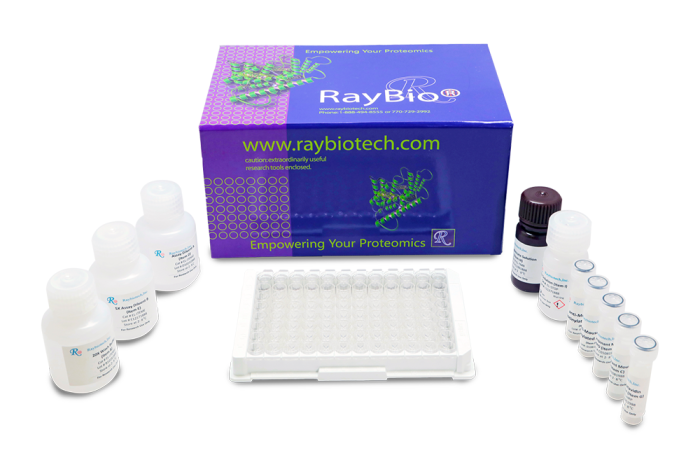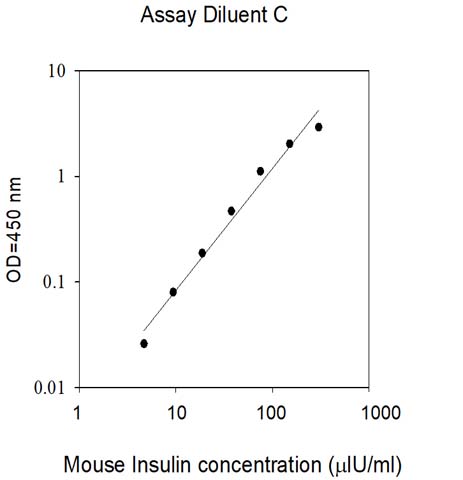RayBio® Mouse Insulin ELISA Kit for cell culture supernatants, EDTA and/or Citrate treated plasma, and serum samples. Heparin is not recommended as an anticoagulant for use in this assay.
Lead time: Typically ships within 1-2 business days. No Friday shipments.
Product Description
Specifications
| Size | 1 Plate Kit, 2 Plate Kit, 5 Plate Kit, 10 Plate Kit |
|---|---|
| Species | Mouse |
| Accession Number | P01325 |
| Gene Id | 16333 |
| Gene Symbols | INS1|INS-1 |
| Protein Name / Synonyms | Insulin-1 [Cleaved into: Insulin-1 B chain Insulin-1 A chain] |
| Quantitative/Semi-Quantitative | Quantitative |
| Specificity | This ELISA antibody pair detects mouse, human, rat, porcine and bovine Insulin. |
| Compatible Sample Types | Cell Culture Supernatants, Plasma, Serum |
| Solid Support | 96-well Microplate |
| Method Of Detection | Colorimetric |
| Design Principle | Sandwich-based |
| Sensitivity | 5 µIU/ml Need more sensitivity? Check out the new BIQ-ELISA™ kit for this target. Still not enough? Then your answer is our Ultrasensitive Biomarker Testing Service powered by Simoa™ technology. |
| Detection Range | 5 µIU/ml - 400 µIU/ml |
| Recommended Dilution (Serum/Plasma) | 2 fold |
| Estimated Lead Time | 1-2 business days |
| Shipping Type | Blue ice |
| Storage | ≤-20°C |
Risk-Free Guarantee
We offer a 100% guarantee on all ELISA kits and membrane cytokine arrays.
Learn More
Amazon Gift Cards!
$5 Amazon gift card in every kit box purchased.
Uday Chandrika, K., Tripathi, R., Kameshwari, Y. et al. Refunctionalization of Decellularized Organ Scaffold of Pancreas by Recellularization: Whole Organ Regeneration into Functional Pancreas. Tissue Eng Regen Med 18, 99-112 (2021). https://doi.org/10.1007/s13770-020-00296-y
Liu Z, Ding Z, Lynch EC, McCauley N, Zhou Y, Zhang KK, Xie L. Pregestational diet transition to normal-fat diet avoids the deterioration of pancreatic ?-cell function in male offspring induced by maternal high-fat diet. J Nutr Biochem. 2020 Dec;86:108495. doi: 10.1016/j.jnutbio.2020.108495. Epub 2020 Sep 16. PMID: 32949717; PMCID: PMC7643480.
Arha, Deepti, et al. "Isoalantolactone derivative promotes glucose utilization in skeletal muscle cells and increases energy expenditure in db/db mice via activating AMPK-dependent signaling." Molecular and cellular endocrinology 460 (2018): 134-151.
Zhou Y, Liu Z, Lynch EC, He L, Cheng H, Liu L, Li Z, Li J, Lawless L, Zhang KK, Xie L. Osr1 regulates hepatic inflammation and cell survival in the progression of non-alcoholic fatty liver disease. Lab Invest. 2020 Oct 1. doi: 10.1038/s41374-020-00493-2. Epub ahead of print. PMID: 33005011.
Abdel-Latif M. Diethylcarbamazine citrate ameliorates insulin resistance in high-fat diet-induced obese mice via modulation of adipose tissue inflammation. Int Immunopharmacol. 2015 Dec;29(2):607-12. doi: 10.1016/j.intimp.2015.09.021.
Mandaliya DK, Patel S, Seshadri S. The Combinatorial Effect of Acetate and Propionate on High-Fat Diet Induced Diabetic Inflammation or Metaflammation and T Cell Polarization. Inflammation. 2021 Feb;44(1):68-79. doi: 10.1007/s10753-020-01309-7. PMID: 32978698.
Eo H., Jeon Yj., Lee M., et al. Brown Alga Ecklonia cava Polyphenol Extract Ameliorates Hepatic Lipogenesis, Oxidative Stress, and Inflammation by Activation of AMPK and SIRT1 in High-Fat Diet-Induced Obese Mice. J Agric Food Chem. 2014 Dec 22.
Othman, Azza I., et al. "Epigallocatechin-3-gallate protects against diabetic cardiomyopathy through modulating the cardiometabolic risk factors, oxidative stress, inflammation, cell death and fibrosis in streptozotocin-nicotinamide-induced diabetic rats." Biomedicine & Pharmacotherapy 94 (2017): 362-373.
Majeed C., Al-Shammari A., Yausif E., et al. BM-MSCs Differentiated Insulin-Producing Cells Produce More Insulin in Presence of EGF than of FGF. Stem Cell Discovery 2015, 5, 33-39. http://dx.doi.org/10.4236/scd.2015.54004
-
ExemplaryAn incredible kit that worked well with our aged mice comparisons.
from Mayo Clinic,
on
Insulin secretionInsulin secretion from MIN 6 cells was evaluated and the standards gave an excellent reading.from Sri Anjaneya Institute ,
on
Excellent AssayThe assay was easy to understand and the values were comparable to another kit we ran. I have no complaints.from Pennsylvania State University,
on
Great productThe kit worked perfectly well for all samples. Plasma samples from obese mice were above detection limit in first trial. Diluting them further worked well the next time.from Case Western Reserve University,
on
Great productExcellenton
Great productPurchased the mouse insulin ELISA kit recently and it detected all plasma samples except few samples from obese mice. They are over the high detection range. Works great and will re-purchase in the future.from University of Iowa,
on
Write Your Own ReviewAsk a Question







